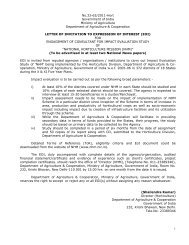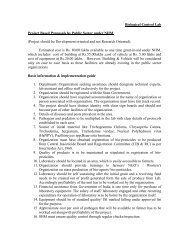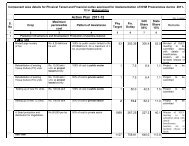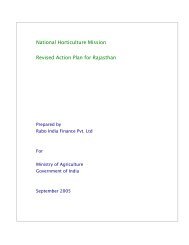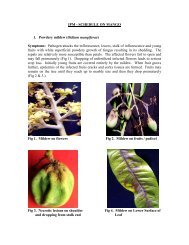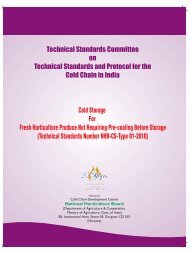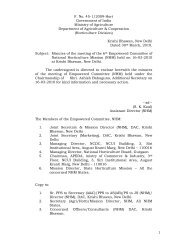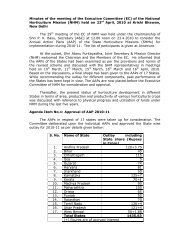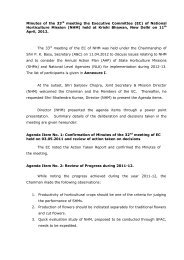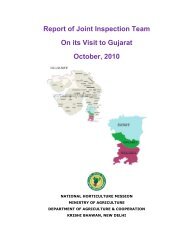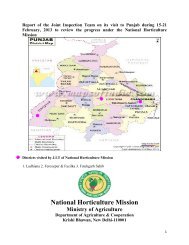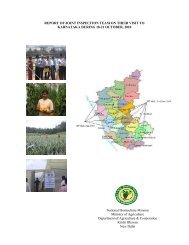National Horticulture Mission Action Plan for Haryana
National Horticulture Mission Action Plan for Haryana
National Horticulture Mission Action Plan for Haryana
Create successful ePaper yourself
Turn your PDF publications into a flip-book with our unique Google optimized e-Paper software.
<strong>National</strong> <strong>Horticulture</strong> <strong>Mission</strong><strong>Action</strong> <strong>Plan</strong> <strong>for</strong> <strong>Haryana</strong>Prepared byRabo India Finance Pvt. Ltd<strong>for</strong>Ministry of AgricultureGovernment of IndiaOctober 2005
NHM - <strong>Action</strong> <strong>Plan</strong> <strong>for</strong> <strong>Haryana</strong>Table of Contents1. Introduction…………………………………………………………………………………………….…32. Potential of <strong>Horticulture</strong> in <strong>Haryana</strong> ……………………………………………………….………..53. Existing and Potential Market Linkages……………………………………………………………124. Selection of Crops <strong>for</strong> intervention and rationale…………………………………………….…185. Prioritization of crop clusters ……………………………………………………………………….216. Recommended <strong>Action</strong> <strong>Plan</strong> <strong>for</strong> 2005-06 <strong>for</strong> <strong>Haryana</strong>………………………………………….267. Summary plans <strong>for</strong> three years …………………………………………………………………….40Annexure…………………………………………………………………………………………………47Rabo India 2
NHM - <strong>Action</strong> <strong>Plan</strong> <strong>for</strong> <strong>Haryana</strong>Chapter 1Introduction1.1 BackgroundRabo India was appointed by the Ministry of Agriculture to review action plan submitted by thestate. Ministry of Agriculture circulated operational guidelines to the States detailing <strong>Mission</strong>objectives, structure, procedures <strong>for</strong> approval and implementation, ongoing schemes, missionintervention and management and Overall targets under NHM. Based on the guidelines, states havesubmitted their reports.The objective of the review is to develop a demand –driven approach <strong>for</strong> horticultural products.The review included the following:• Identification of Market linkages of production areas in each of the states witho Agri Export Zoneso Food Parkso Existing processing facilitieso Terminal Marketso Existing mandiso Ports• Mapping of production clusters of various horticultural crops with markets• Prioritization of crops and clusters• Identification of quality and varietal issues as per the market needs• Identify missing links between farmers and processors, traders and retailers1.2 MethodologyRabo discussed the initial plan with the state horticulture department. It was followed by collectionof data <strong>for</strong> mapping market linkages (Food Parks, AEZs, Processing facilities, pack houses, coldstorages, mandis). Rabo held discussions with other stakeholders including processors withfacilities in the state and traders in mandis. Rabo also used its existing databases and internationalnetwork.Rabo India 3
NHM - <strong>Action</strong> <strong>Plan</strong> <strong>for</strong> <strong>Haryana</strong>1.3 Guiding Principals under NHMThe horticulture sector has contributed significantly to GDP in agriculture (28.5 per cent from 8.5per cent area). The objective of the <strong>National</strong> <strong>Horticulture</strong> <strong>Mission</strong> is to double the horticultureproduction, i.e. to achieve a production of 300 million tonnes by 2011-12.The <strong>Mission</strong> would adopt an end-to-end approach covering production, post harvestmanagement, processing and marketing to assure appropriate returns to growers/producers;promote Research and Development (R&D) of technologies <strong>for</strong> production, post-harvestmanagement and processing in potential belts/clusters; Enhance acreage, coverage, andproductivity in potential belts/clusters; Adopt a coordinated approach and promote partnership,convergence and synergy among R&D, processing and marketing agencies in public as well asprivate sectors, at all levels; promote, where appropriate, <strong>National</strong> Dairy Development Board modelof cooperatives to ensure support and adequate returns to farmers; Facilitate capacity-buildingand Human Resource Development. State and sub-state level structures will be evolved, keeping inview the need <strong>for</strong> getting adequate returns <strong>for</strong> the produce of the farmers and eliminatingmiddlemen to the extent possible.Rabo India 4
NHM - <strong>Action</strong> <strong>Plan</strong> <strong>for</strong> <strong>Haryana</strong>Chapter 2Potential of <strong>Horticulture</strong> in <strong>Haryana</strong>2.1 BackgroundThe State of <strong>Haryana</strong> is situated between 27 o 39’ to 30 o 56’ N latitude and 74 o 27’ to 77 o 36’ Elongitude and comprises 20 2istricts as shown in Exhibit 2.1Exhibit 2.1 District-wise map of <strong>Haryana</strong>The state has a geographical area of44,212 square kilometres and occupies1.35% of the land area of the country.The State has natural geographicalboundaries with the Shivalik Hills to theNorth, the river Yamuna to the East andthe river Ghaggar to the West. Thesouthwest of the state is bounded bythe Aravalli hills which run throughsouthern Delhi and Gurgaon district upto Alwar in Rajasthan. The state has arich diversity of horticultural crops dueto the presence of diverse agro climaticzones ranging from subtropical andsemi-arid to sub-humid. The averagerainfall is 560 mm, varying from lessthan 300 mm in the southwestern partsto over 1200 mm in hilly tracts of theShivalik Hills.Agriculture contributes 29.4% of the state’s GDP and employs 71.1% of the total work<strong>for</strong>ce. Thenet sown area is 79% of the total geographic area as compared to the national average of 46%, thegross cropped area is 60.3 lakh Ha with a cropping intensity of 17.4%. Small and marginal farmersaccount <strong>for</strong> 10.9% of the total land holding which <strong>for</strong>ms 23.9% of the operated area. The averagelandholding in the state is 2.13 Ha. Irrigation covers 85.8% of the net sown area and the remaining14.2% is rainfed. <strong>Horticulture</strong> crops cover 4.9% of the gross cropped area, corresponding to 2.47lakh Ha and with an annual production of horticulture crops in the state is 31.1 lakh tonnes.Rabo India 5
NHM - <strong>Action</strong> <strong>Plan</strong> <strong>for</strong> <strong>Haryana</strong>2.2 Production strengths of <strong>Haryana</strong> in <strong>Horticulture</strong>The total area under fruits was 7,865 Ha with a total production of 27,527 MT during 1966-67,which had increased to 24,071 Ha with a total production of 2.47 lakhs MT by the end of 2004-05. The total area under vegetable was 11,305 ha with a total production of 1,35,360 MT during1966-67, which had increased to 2.08 lakhs Ha with a total production of 27.67 lakhs MT by theend of 2004-05. There was no flower cultivation in the state during 1966-67 but covered 4,810Ha during 2004-05. Similarly, mushroom cultivation picked up during 1989-90 and by the end of2004-05, production was to the extent of 6,163 MT and the state is now the highest producer ofmushroom in the country. Cultivation of aromatic plants is also increasing due to higher returnsand by the end of 2004-05 extended to 3,666 Ha. The details of horticulture production areencapsulated in Exhibit 2.2.Exhibit 2.2 Area, Production and Productivity of Horticultural cropsArea (Ha) Production (Lakh MT) Productivity (MT/Ha)Crop02-03 03-04 04-05 02-03 03-04 04-05 02-03 03-04 04-05Fruits 31,856 31,611 24,071 237,270 257,200 2,47,600 7.45 8.14 10.29Vegetables 1,63,000 2,03,740 2,07,750 22,45,200 27,01,300 27,67,300 13.77 13.26 13.32Spices 14,148 8,603 8,121 87,332 87,332 42,450 6.17 10.15 5.23Flowers 3,600 4,286 4,8101,20032,500*460.558,333*50855,583*- - -Medicinal &Aromatic <strong>Plan</strong>ts529 3,035 2,316 238 739 348 0.45 0.24 0.15Total 213,133 251,275 247,068 2,571,24030,47,031 30,58,206 27.85 31.79 28.98Source - <strong>Haryana</strong> state horticultural departmentThe state ranks sixth in the production of Sapota, 13 th in citrus production, 15 th in guavaproduction and 17 th in mango production.Rabo India 6
NHM - <strong>Action</strong> <strong>Plan</strong> <strong>for</strong> <strong>Haryana</strong>2.3 Production of various Horticultural cropsA) FruitsMango, guava and citrus crops are the leading fruit crops in <strong>Haryana</strong> accounting <strong>for</strong> over 66% ofthe area under fruit and over 62% of the total fruit production. Off-season production of mango isa distinguishing feature in <strong>Haryana</strong>.Exhibit 2.3 (A) – Fruit (Area and Production)Area (000’ Ha)Total = 24Production (000’ MT)Total =247.6Others, 3.7Mango, 7.6Others, 42.1Mango, 50.7Guava, 4.0Guava, 57.1Grape, 0.1Citrus, 45.8A onla, 1.4Grape, 5.1Ber, 3.0Citrus, 4.3Aonla, 8.1Ber, 38.7Exhibit 2.3 (B) – Fruit (Main Production areas)FRUITMAIN PRODUCTION AREASMangoGuavaCitrusSapotaBerAonlaPanchkula, Ambala, Yamunanagar, Karnal, KurukshetraGurgaon, Karnal, Hisar, Faridabad, SonipatSirsa, Hisar, Ambala, Gurgaon, FatehabadYamunanagar, Karnal, Panchkula, Kurukshetra, AmbalaSonipat, Gurgaon, Hisar, Fatehabad, RohtakGurgaon, Sirsa, Hissar, Karnal, FaridabadRabo India 7
NHM - <strong>Action</strong> <strong>Plan</strong> <strong>for</strong> <strong>Haryana</strong>B) VegetablesThe main vegetables grown in <strong>Haryana</strong> are Potatoes, Cauliflower, Cucurbits, Carrots, Tomatoes,Radish and Onions. These account <strong>for</strong> over 61% of the total area and over 67% of production ofvegetables.Exhibit 2.3 (C) – Vegetables (Area and Production)Area (000’ Ha)Total = 207.75Potato, 18.4Production (000’ MT)Total =2,767.3Onion, 17.2Potato, 367.8Others, 96.6Cauliflow er,17.0Tomato, 13.8Others,1245.7Onion, 216.3Cauliflow er,268.8Ladyfinger,12.7Cucurbits,32.2Ladyfinger,98.5Cucurbits,350.5T omato,219.7Exhibit 2.3 (D) – Vegetables (Main Production areas)VEGETABLE (incl. Tubers)MAIN PRODUCTION AREASPotatoOnionCauliflowerTomatoCucurbitsKurukshetra, Yamunanagar, Ambala, KarnalGurgaon, Sonipat, Panipat, PanchkulaSonipat, Panipat, Gurgaon, YamunanagarKarnal, Sonipat, Yamunanagar, KurukshetraKarnal, Sonipat, Panipat, GurgaonRabo India 8
NHM - <strong>Action</strong> <strong>Plan</strong> <strong>for</strong> <strong>Haryana</strong>C) SpicesThe main spices grown are Garlic, Turmeric, Fenugreek, Coriander and Ginger.Exhibit 2.3 (E) – Spices (Area and Production)Area (000’ Ha)Total = 8.1Production (000’ MT)Total =42.45Ginger, 0.1 T urmeric, 0.7Ginger, 0.1Turmeric, 0.7Fenugreek, 3.1Fenugreek, 3.1Garlic, 2.5Garlic, 2.5Chillies, 0.3Chillies, 0.3Coriander, 1.4Fennel, 0.0Coriander, 1.4Fennel, 0.0Exhibit 2.3 (F) – Spices (Main Production areas)SPICESMAIN PRODUCTION AREASTurmericChilliesGarlicFenugreekCorianderYamunanagar, Kurukshetra, Ambala, PanchkulaYamunanagar, Karnal, Hisar, Fatehabad, JindKarnal, Yamunanagar, Fatehabad, Gurgaon, SirsaGurgaon, Hisar, Mahendergarh, Jind, KurukshetraKurukshetra, Karnal, Gurgaon, Panchkula, AmbalaRabo India 9
NHM - <strong>Action</strong> <strong>Plan</strong> <strong>for</strong> <strong>Haryana</strong>C) FlowersThe main flowers grown in <strong>Haryana</strong> are Marigold, Rose, Tuberose and Gladiolus.Exhibit 2.3 (G) – Flowers (Area of Production)Area (Ha)Others,1,318Gladiolus,1,238marigold, 60Rose, 246T uberose,618Exhibit 2.3 (H) – Flowers (Main production areas)FLOWERGladiolusTuberoseRoseMarigoldMAIN PRODUCTION AREASFaridabad, Gurgaon, Karnal, PanchkulaFaridabadPanipat, Sonipat, Gurgaon, KaithalGurgaon, Sonipat, Jind, Jhajjar, Faridabad2.4 Consumption of Horticultural products in <strong>Haryana</strong>The consumption of Fruits and Vegetables is growing at a faster rate as compared to other foodproducts as seen in Exhibit 2.4Exhibit 2.4 - Consumption of Food Products in <strong>Haryana</strong> (Rs. (Crores) – at 1993-94 94 prices1996 1997 1998 1999 2000 2001 2002 CAGRCereals 1,132 372 1,515 1,847 1,6501,674 1,695 7.0%Gram 30 11 23 32 27 28 26 -2.2%Pulses 253 87 281 477 417 404 411 8.4%Milk & milkproducts 2,819 717 2,913 3,748 3,676 3,959 3,857 5.4%Edible oil 315 112 317 409 329 379 386 3.5%Rabo India 10
NHM - <strong>Action</strong> <strong>Plan</strong> <strong>for</strong> <strong>Haryana</strong>Meat, egg, fish 80 23 59 94 69 103 88 1.5%Vegetables 467 183 646 875 777 976 1,015 13.8%Fruits( fresh) 190 79 169 280 273 307 341 10.2%Fruits (dry) 34 10 16 45 45 34 32 -1.3%Sugar 446 110 514 664 565 551 571 4.2%Salt 17 7 21 27 30 30 30 9.7%Spices 165 56 192 321 264 270 263 8.1%Beverage etc. 386 218 473 620 752 920 912 15.4%Food Total 6,334 1,985 7,139 9,439 8,873 9,635 9,628 7.2%Source – NSSO dataRabo India 11
NHM - <strong>Action</strong> <strong>Plan</strong> <strong>for</strong> <strong>Haryana</strong>2.5 SWOT analysis – Horticultural Scenario in <strong>Haryana</strong>Strengths• Favorable climate <strong>for</strong> production of quality spices,Kinnow, Sapota, Mango, Aonla, Guava, Ber• Proximity to major markets like Azadpur near DelhiWeaknesses• Water scarcity• Lesser-availability of quality seeds of vegetable andspices and quality planting material of fruits• Poor post harvest management and marketing facilitieslike cold storage, pre-cooling and waxing centers,processing units etc• Lack of farmer training programmes <strong>for</strong> horticultureOpportunities• Proximity to NCR offers excellent marketing channels• Establishment of Processing IndustriesThreatsRelatively weaker marketing & post harvest management• Export of flowers to EU, Mango to Far EastRabo India 12
NHM - <strong>Action</strong> <strong>Plan</strong> <strong>for</strong> <strong>Haryana</strong>Chapter 3Existing and Potential Market LinkagesHorticultural crops being perishable in nature are subject to post harvest losses. Factors likerespiration, ethylene production, evaporation, temperature and relative humidity affects thekeeping quality of these products. Post harvest facilities from production linking to the market andconsumption points help in the reduction of losses due to wastage. The existing marketinfrastructure in post harvest facilities like cold storage and the avenues <strong>for</strong> sale in terms ofmarket and mandi linkages are discussed in detail in this chapter. Agri Export Zones (AEZs) arepromoted with the objective of promoting exports of agricultural produce from selected areas ofproductivity prominence, while food parks provide an opportunity of increasing processingcapabilities in the state. The AEZs and the Food Parks are two important linkage points which helpsin absorption of Fruits and Vegetables <strong>for</strong> further value addition.3.1 Food Parks & AEZsExhibit 3.1 Location of Food parksCurrently, there are no Food Parks in the statebut 4 parks are planned in the districts of Sirsa,Jind, Sonipat and Ambala. While the food parks inJind and Sirsa are still in the conceptual stage, theGovernment of India has already invested in thefood parks at Rai in Sonepat & Saha in Ambala.The locations of the above mentioned food parksare shown in Exhibit 3.1There are no AEZs in the state at present.Rabo India 13
NHM - <strong>Action</strong> <strong>Plan</strong> <strong>for</strong> <strong>Haryana</strong>3.2 MandisThe major markets <strong>for</strong> leading horticultural crops are shown in Exhibit 3.2. These are located inthe major production areas <strong>for</strong> each crop. Overall, there are 106 Agriculture Produce MandiCommittees in the State, and 40 markets <strong>for</strong> fruit and vegetables (F&V).Exhibit 3.2 Major markets <strong>for</strong> horticulture produce3.3 Processing unitsThere are 29 F&V processing centres in the state at present. Details of the main units are as shownin Exhibit 3.3.Exhibit 3.3 Major processing centres <strong>for</strong> horticulture produceRabo India 14
NHM - <strong>Action</strong> <strong>Plan</strong> <strong>for</strong> <strong>Haryana</strong>NoDistrictUnitsProducts1 Panchkula 1 Aloe Vera Gel, Health products2 Ambala 2 F&V products3 Kaithal 1 Pickles4 Panipat 5 Pickles, Jams, Sauces, Muraba5 Sonipat 8 Ready-to-eat veg, Curries, pickles, mushrooms6 Rohtak 3 Pickles, Jams, Sauces7 Gurgaon 4 Barley malt extraction, mushroom8 Rewari 4 Pickles, Barley Malt9 Bhiwani 1 Guar gumTotal 293.4 Cold storages and pack housesThere are 107 cold stores in the state that cater primarily to vegetables and onions. The totalcapacity of these stores is more than 64,000 MT.Exhibit 3.4 Locations of cold store in <strong>Haryana</strong>Rabo India 15
NHM - <strong>Action</strong> <strong>Plan</strong> <strong>for</strong> <strong>Haryana</strong>Currently, there are no pack houses in the state. Under the <strong>Action</strong> plan <strong>for</strong> 2005-06, 21 Multipurposepack houses are proposed to be set up across 14 districts. Similarly, 2 Refrigerated vansare also proposed along with 9 new cold stores and 6 grading and polishing units.Rabo India 16
NHM - <strong>Action</strong> <strong>Plan</strong> <strong>for</strong> <strong>Haryana</strong>Chapter 4Selection of Crops <strong>for</strong> fintervention and rationaleThe focus crops were selected on the basis of the following parameters Market linkages (existing and potential) Production advantage – potential in the domestic market Export potentialExhibit 4.1 Market linkages and potential tial <strong>for</strong> focus cropsCropsMarket LinkagesDomesticExportFoodAEZ /Mandis Processing UnitsCold Storages / Ref.MarketPotentialParksExportvans / Pack housesPotentialMango High MediumSapota High MediumCitrus High MediumGuava High HighBer High MediumChilli High HighGarlic High HighFlowers High LowAromatic High Low<strong>Plan</strong>tsRabo India 17
NHM - <strong>Action</strong> <strong>Plan</strong> <strong>for</strong> <strong>Haryana</strong>Exhibit 4.2 Focus crops and rationaleFocus Crop % Share of AllRationaleIndiaProductionMango 0.4% Increase production to cater to domestic and export (fresh& processed) demandImprove productivity through replacement /rejuvenationLocal traditional varieties have high demandSapota 2.8% Large scope <strong>for</strong> area expansion and productivityimprovement and processingConsolidate presence in domestic market and exploreexport opportunitiesCitrus 0.9% Improve productivity through replacement /rejuvenationGuava 2.0% Potential <strong>for</strong> enhancing market shareBer N.A. Tap large domestic potentialAromatic<strong>Plan</strong>tsN.A. Growing demand <strong>for</strong> herbal base cosmetics and perfumesFlowers3.3% (loose)4.4% (cut) Thrust on meeting demand from NCR throughimprovement in pre & post harvest practices Increase focus on exports through high value flowersChilli 4.4% Potential <strong>for</strong> export of dried chillies, extraction ofoleoresins / high value derivativesPotential <strong>for</strong> developing organic chilly productionGarlic 5.1% Potential <strong>for</strong> export as well as processingRabo India 18
NHM - <strong>Action</strong> <strong>Plan</strong> <strong>for</strong> <strong>Haryana</strong>Exhibit 4.3 Focus crops and districtsFocus NHM DistrictsAs seen in Exhibit 4.3, 14 districts (out of 20) have been shortlisted <strong>for</strong> under the <strong>National</strong><strong>Horticulture</strong> <strong>Mission</strong> based on their respective production strengths and potential <strong>for</strong> furtherdevelopment.Rabo India 19
NHM - <strong>Action</strong> <strong>Plan</strong> <strong>for</strong> <strong>Haryana</strong>Chapter 5Prioritization of crop clusters5.1 Focus Crops and Clustersa) Mango cluster- Panchkula, Ambala, YamunanagarPanchkulaAmbalaYamunanagarKurukshetraSirsaKaithalKarnalFatehabadHisarBhiwaniJindPanipatSonipatRohtakJhajjar Area Expansion – 175 Ha Varieties – Dusehri, Langra, Chousa, Ramkela Nurseries – 5 Rejuvenation / Replacement – 150 Ha IPM / INM proposed – 100 HaMahendergarhRewariGurgaonMewatFaridabadb) Sapota cluster- Panchkula, Ambala, YamunanagarPanchkulaAmbalaYamunanagarKurukshetra• Area Expansion – 100 Ha• Varieties – cricket ball• IPM / INM proposed – 100 HaSirsaFatehabadKaithalJindKarnalPanipatHisarSonipatRohtakBhiwaniJhajjarMahendergarhRewariGurgaonMewatFaridabadRabo India 20
NHM - <strong>Action</strong> <strong>Plan</strong> <strong>for</strong> <strong>Haryana</strong>c) Citrus cluster- Sirsa, Fatehabad, HisarPanchkulaAmbalaKurukshetraYamunanagar• Area Expansion – 450 Ha• Varieties – KinnowSirsaFatehabadJindKaithalKarnalPanipat• Nurseries – 4• Rejuvenation / Replacement – 50 Ha• Organic farming – 100 HaHisarSonipat• IPM / INM proposed – 150 HaRohtakBhiwaniJhajjarMahendergarhRewariGurgaonMewatFaridabadd) Guava cluster- Karnal, Panipat, Sonipat, Rohtak, Faridabad, Mewat, Gurgaon, JhajjarPanchkulaAmbalaKurukshetraYamunanagar• Area Expansion – 200 Ha• Nurseries – 1SirsaKaithalKarnal• Organic Farming – 50 HaFatehabadJindPanipatHisarSonipatRohtakBhiwaniJhajjarMahendergarhRewariGurgaonMewatFaridabadRabo India 21
NHM - <strong>Action</strong> <strong>Plan</strong> <strong>for</strong> <strong>Haryana</strong>e) Ber cluster- Sonipat, Rohtak, Faridabad, Mewat, Gurgaon, JhajjarPanchkulaAmbalaKurukshetraYamunanagar• Area Expansion – 150 Ha• Nurseries - 1SirsaKaithalKarnalFatehabadJindPanipatHisarSonipatRohtakBhiwaniJhajjarMahendergarhRewariGurgaonMewatFaridabadf) Floriculture cluster- Karnal, Panipat, Sonipat, Rohtak, Faridabad, Mewat, Gurgaon, JhajjarPanchkulaAmbalaKurukshetraYamunanagar• Area Expansiono Cut flowers - 40 Hao Bulbous flowers - 195 HaSirsaKaithalKarnaloHigh value loose flowers - 865 HaFatehabadHisarJindPanipat• Varieties – Chrysanthemum, Gladiolus, Marigold,Carnation, Lilium, RoseBhiwaniRohtakJhajjarSonipat• Nurseries – 1• Organic farming – 50 Ha• IPM / INM proposed – 150 HaMahendergarhRewariGurgaonMewatFaridabadRabo India 22
NHM - <strong>Action</strong> <strong>Plan</strong> <strong>for</strong> <strong>Haryana</strong>g) Aromatic <strong>Plan</strong>ts cluster- Panchkula, Ambala, Yamunanagar, Karnal, Gurgaon, Jhajjar, Faridabad, MewatPanchkulaAmbalaYamunanagarKurukshetraSirsaFatehabadJindKaithalKarnalPanipat• Area Expansion – 245 Ha• Varieties – Aloe Vera, Damask Rosa, Palma Rosa,Lemon Grass, CitronellaHisarRohtakSonipat• Nurseries – 5• IPM / INM proposed – 100 HaBhiwaniJhajjarMahendergarhRewariGurgaonMewatFaridabadh) Chilli cluster- Sirsa, Fatehabad, Hisar, Rohtak, Sonipat, Panipat, Karnal, Jhajjar, Gurgaon, Mewat, FaridabadPanchkulaAmbalaKurukshetraYamunanagarSirsaKaithalKarnal• Area Expansion – 375 HaFatehabadJindPanipat• Varieties – CH1, Pusa JwalaHisarRohtakSonipat• Organic farming – 50 Ha• IPM / INM proposed – 100 HaBhiwaniJhajjarMahendergarhRewariGurgaonMewatFaridabadRabo India 23
NHM - <strong>Action</strong> <strong>Plan</strong> <strong>for</strong> <strong>Haryana</strong>i) Garlic clusterc- Sirsa, Fatehabad, Hisar, Rohtak, Panchkula, Ambala, Yamunanagar, KarnalPanchkulaAmbalaKurukshetraYamunanagarSirsaKaithalKarnal• Area Expansion – – 300 HaFatehabadHisarJindRohtakPanipatSonipat• Varieties – Parvati, Yamuna Safed• IPM / INM proposed – 100 HaBhiwaniJhajjarMahendergarhRewariGurgaonMewatFaridabad5.2 Summary of Investments required along the chainAreaRequirement ofSource of plantingIPM /OrganicPackExpansionplanting materialmaterialINM(Ha)houses(Ha)(Ha)withinclusterMango 175 17,500 GGN, privatenurseriesSapota 100 10,000 GGN, privatenurseriesCitrus 450 1.25 lakh nos. GGN, Rajasthan,PunjabGuava 200 GGN, privatenurseriesBer 150 41,500 nos. GGN, privatenurseries100 0 8*100 0 8*150 100 4*0 0 7*0 0 5*Aromatic <strong>Plan</strong>ts 245 GGN 100 0 9*Flowers 1100 120 lakh nos. Imported 150 50 13*Chilli 375 375 kg Private companies 100 50 11*Garlic 300 140 MT NHRDF 100 0 13** ProposedRabo India 24
NHM - <strong>Action</strong> <strong>Plan</strong> <strong>for</strong> <strong>Haryana</strong>Chapter 6Recommended <strong>Action</strong> <strong>Plan</strong> <strong>for</strong> 2005-06 06 <strong>for</strong> <strong>Haryana</strong>6.1 <strong>Plan</strong>tation infrastructure and developmentIn order to ensure adequate quantity of planting materials, 2 Model and 4 small Nurseries (Publicsector), 2 Model and 2 small nurseries (Private sector) are proposed to be set up in 2005-06. Inaddition, rehabilitation of 1 Tissue culture unit will be undertaken in the Public sector. The detailsare indicated in Exhibit 6.1Exhibit 6.1 – Focus crops <strong>for</strong> various Nurseries and Tissue Culture unitsNo. DistrictModel NurserySmallCropPublicPrivate PublicPrivate1 Panchkula - - 1 - Mango, Sapota, Aromatic2 Ambala 1 - - - Mango, Sapota, Aromatic3 Yamunanagar - 1 1 1 Mango, Sapota, Aromatic4 Rohtak - - - - -5 Gurgaon - - 1 - Flowers6 Hisar - - 1 - Citrus7 Fatehabad - - - 1 Citrus8 Sirsa 1 1 - - CitrusTotal 2 2 4 2 -The infrastructure facilities, when provided to all such existing areas of seed production, couldhelp enhance seed production by 30% in the first year and 40% in second year.Rabo India 25
NHM - <strong>Action</strong> <strong>Plan</strong> <strong>for</strong> <strong>Haryana</strong>The total financial assistance sought <strong>for</strong> Production and distribution of planting material and seedinfrastructure (all components) in 2005-06 06 is Rs 365.9 lakhs.6.2 Establishment of new gardensIt is proposed to undertake area expansion in 3,095 Ha in 2005-06, across 9 horticultural crops in<strong>Haryana</strong>. The district wise break up is provided in Exhibit 6.2 (A) and (B). The total financialassistance sought <strong>for</strong> establishment of new gardens in 2005-06 06 is Rs 366.5 LakhsExhibit 6.2 (A)– Summary of Area Expansion (District wise)MangoSapota CitrusGuavaBerFlowersAromatic <strong>Plan</strong>ts ChilliGarlicTotal1 Panchkula 25 25 0 0 0 0 10 0 20 802 Ambala 75 25 0 0 0 0 10 0 20 1303 Yamunanagar 75 50 0 0 0 0 45 0 80 2505 Karnal 0 0 0 25 0 55 5 25 100 2107 Panipat 0 0 0 25 0 115 0 25 0 1658 Sonipat 0 0 0 25 50 175 0 25 0 2759 Rohtak 0 0 0 25 20 40 0 25 20 13011 Faridabad 0 0 0 25 20 105 55 25 0 23012 Mewat 0 0 0 25 20 180 45 25 0 29513 Gurgaon 0 0 0 25 20 250 65 25 0 38514 Jhajjar 0 0 0 25 20 180 10 25 0 26018 Hisar 0 0 50 0 0 0 0 50 20 12019 Fatehabad 0 0 150 0 0 0 0 25 20 19520 Sirsa 0 0 250 0 0 0 0 100 20 370Total 175 100 450 200 150 1100 245 375 300 3095Exhibit 6.2 (B) – Summary of Area Expansion of Flowers (District wise)DistrictSmall & Marginal al FarmersOther FarmersTotalCutBulbousLooseCut FlowersBulbous FlowersLooseFlowerChrysanthemumFlowersFlowersFlowersTubeRoseGladiolusRoseMarigoldChrysanth Carnat Gladiolus Lilium Rose Maremum ionigold1 Karnal 0 0 10 0 10 5 0 5 0 0 25 552 Panipat 0 0 10 0 50 0 0 5 0 0 50 1153 Sonipat 0 0 10 5 100 0 0 5 0 5 50 1754 Rohtak 0 0 0 0 10 0 0 5 0 0 25 406 Faridaba0 20 10 0 15 0 0 10 0 0 50 105d7 Mewat 0 10 10 0 100 0 0 10 0 0 50 180Rabo India 26
NHM - <strong>Action</strong> <strong>Plan</strong> <strong>for</strong> <strong>Haryana</strong>8 Gurgaon 20 20 10 10 100 10 5 10 5 10 50 2509 Jhajjar 0 10 10 0 100 0 0 10 0 0 50 180Total 20 60 70 15 485 15 5 60 5 15 350 11006.3 Rejuvenation and Replacement of senile plantationMany of the fruit orchards have low productivity. These senile orchards need to be rejuvenatedwith latest high yielding varieties by adopting top working methods. Considering the total area,200 Ha is proposed under rejuvenation as indicated in Exhibit 6.3. The total financial assistancesought <strong>for</strong> Rejuvenation and Replacement of senilesgardens in 2005-06 06 is Rs 303LakhsExhibit 6.3 - Rejuvenation of senile plantationsCrop-wise Area Proposed <strong>for</strong> Rejuvenation (Ha)MangoSapotaCitrusGuavaBer AonlaStrawberryFlowersGingerTurmeriChilliesGarlicCoriandFenugreekTotalcerPanchkula 20 - - - - - - - - - - - - - 20Ambala 30 - - - - - - - - - - - - - 30Yamunanagar 100 - - - - - - - - - - - - - 100Rohtak- - - - - - - - - - - - - - -Gurgaon - - - - - - - - - - - - - - -Hisar- - 10 - - - - - - - - - - - 10Fatehabad - - 15 - - - - - - - - - - - 15Sirsa- - 25 - - - - - - - - - - - 25Total 150 - 50 - - - - - - - - - - - 2006.4 Creation of water resources<strong>Haryana</strong> is a water scarce state with primarily brackish water throughout. In order to improve thescarcity of water, it is estimated that during 2005-2006, it will be required to establish 9 tanks indifferent districts. The cost of the each structure is approximately Rs. 10 lakhs. The total financialassistance sought in 2005-06 06 is Rs 909Lakhs.Rabo India 27
NHM - <strong>Action</strong> <strong>Plan</strong> <strong>for</strong> <strong>Haryana</strong>6.5 Protected CultivationDuring recent years, many of the farmers are becoming entrepreneurs and venture into GreenHouse cultivation making use of the existing schemes including the programmes of NHB. Theprogressive farmers need to be supported so that they can successfully tap the export market.Hence, there is a proposal to provide nearly 10,000 sqm of Green House and 100 ha of Net in<strong>Haryana</strong>. The total financial assistance sought in 2005-06 06 <strong>for</strong> all initiatives under protectedcultivation is Rs 117.11Lakhs (Refer Exhibit 6.5).Exhibit 6.5 – Initiatives under protected cultivationSl.DistrictGreen HouseMulchingShade Net & Bird NetPlastic TunnelNo.Small marginalOther farmersFarmersHi-TechNormalHi-TechNormal(Sqm) (Sqm) (Sqm) (Ha) (Ha) (Ha)1 Panchkula - - - - 10 10 52 Ambala - - - - 10 10 53 Yamuna Nagar --15 20 101,0001,0004 Rohtak --20 10 101,0001,0005 Gurgaon -2,00030 20 152,0002,0006 Hisar - - - - 5 10 57 Fatehabad - - - - 10 10 58 Sirsa - - - - - 10 -Total - 4,000 2,000 4,000 100 100 556.6 Promotion of IPM /INMThe field losses, due to pest, diseases and inadequate nutrient management, is estimated to bearound 30 to 40%. The present mind-set of the farmers to go <strong>for</strong> independent pesticides/fungicide application in fact aggravates the pest and disease load thereby doubling the number ofsprays per crop. Further, residual toxic pollution occurs in the soil, water and also in horticulturalproduce. Hence there is an immediate need to promote INM/ IPM practices with the objective ofreducing the expenses of plant protection operation, toxic load in soil and water besides ensuringfood safety through toxic free horticultural produce. Hence, there is a proposal to promoteINM/IPM practices in an area of 800 Ha It is proposed to establish one Disease Forecasting Unit atCCS HAU, Hisar <strong>for</strong> <strong>for</strong>ecasting the attack of insect-pest and diseases well in time, so that effectivecontrol measures could be suggested to the farmer <strong>for</strong> control of reported insect-pests anddiseases well in time. It is also proposed to establish a bio-control lab and establish/strengthenRabo India 28
NHM - <strong>Action</strong> <strong>Plan</strong> <strong>for</strong> <strong>Haryana</strong>the Leaf/Tissue Analysis Lab in public sector at CCS HAU, Hisar (Refer Exhibit 6.6). The totalfinancial assistance sought in 2005-06 06 <strong>for</strong> all initiatives under IPM I/INM is Rs 212 LakhsExhibit 6.6 – Area under INM /IPM (Ha)Sl.DistrictDiseaseBio-Leaf<strong>Plan</strong>t Health ClinicsPromotion ofNo.ForecastingUnitcontrolLabTissueAnalysisIPMLabPublicSectorPrivateSector(Nos.)(Nos.)(Nos.)(Nos.)(Ha)a) CCS HAU Hisar 1 1 1b)1 Panchkula-12 Ambala10013 Yamuna Nagar10019 Rohtak100110 Gurgaon 15011 Hisar200112 Sirsa1501Total 1 1 1 4 2 800Rabo India 29
NHM - <strong>Action</strong> <strong>Plan</strong> <strong>for</strong> <strong>Haryana</strong>6.7 Organic FarmingBio-logical activities of the soil are declining due to increase in fertilizer doses which is reflectedin reduced levels of organic matter and reduced fertilizer efficiency of carbon and other majornutrients in the soils, which needs to be restored. Secondly, the increased use ofinsecticides/herbicides has lead to residual contents of pesticides in soil and in food stuff, and theindiscriminate use has further lead to insurgence in pest population with some pests evenacquiring resistance against the commonly used pesticides. In addition, with the increasingawareness of consumers regarding the dangers of chemicals to their health and environment,organically grown produce fetch a premium thereby providing new opportunities <strong>for</strong> farming andbusiness around the world. There<strong>for</strong>e, the adoption of Organic Farming by way of minimizing theuse of synthetic chemicals in the production and post harvest management of horticulture producehas become imperative. It is proposed to bring 250 ha under organic farming in the districts ofPanchkula, Rohtak, Gurgaon and Sirsa. In these districts, some of the growers have taken uporganic farming on a commercial scale and need to be assisted with proper registration andcertification with national/International agencies to compete with the growing commercializationof organic farming. Further, 95 vermicompost units will be constructed in Panchkula, Ambala,Yamunanagar, Rohtak, Gurgaon, Hisar, Fatehabad and Sirsa. The total financial assistance sistance soughtin 2005-06 06 <strong>for</strong> all initiatives under Organic farming (all components) is Rs 83.5 Lakhs.Exhibit 6.7 – Summary of initiatives under Organic farmingUnitsRs. Lakhs(I) Adoption of organic farming 250 Ha 25.0(ii) Vermi-compost Units 95 28.5(iii) Certification 6 30.0Sub Total 83.56.8 HRD including <strong>Horticulture</strong> InstituteFor the year 2005-06, a target of imparting training to 750 farmers at HTI, Uchani (Karnal), 120farmers at HAIC, Murthal (Sonipat) and 200 farmers outside the State has been identified. Trainersat the level of Project Officers, District <strong>Horticulture</strong> Officers and extension workers will be trainedin the modern technological advances in <strong>Horticulture</strong> at various ICAR Institutes within or outsidethe State. Similarly, 100 staff members will be trained at the <strong>Horticulture</strong> Training Institute, Uchani(Karnal). These officers, in turn, will train the staff and farmers in their respective regions.Rabo India 30
NHM - <strong>Action</strong> <strong>Plan</strong> <strong>for</strong> <strong>Haryana</strong>To meet the objectives of the <strong>Mission</strong>, short-term courses in nursery production, seed production,grading and packing, food processing, Flowers, Medicinal & Aromatic <strong>Plan</strong>ts, and safe storage ofperishable commodities would be started. Under this programme, training will be imparted toSupervisors, Gardeners and Entrepreneurs. The courses will be of one-year duration <strong>for</strong>supervisors, six months <strong>for</strong> gardeners and three months <strong>for</strong> Entrepreneurs.The courses will be residential and at the end of the training, Supervisors will be awarded aDiploma in <strong>Horticulture</strong> and Gardeners and Entrepreneurs a Certificate of training in <strong>Horticulture</strong>.The minimum qualification <strong>for</strong> Supervisory and Entrepreneurs training programmes would beHigher Secondary and <strong>for</strong> Gardeners, Class-VIII (Middle) Standard.The total financial assistance sought in 2005-06 06 <strong>for</strong> all initiatives under HRM is Rs 76.2 Lakhs(Refer Exhibit 6.8).Exhibit 6.8 – Summary of initiatives under HRDSl.ComponentNo.1 Farmers2 Project Officers/Trainers/Distt.<strong>Horticulture</strong>Officer3 ShortCoursesTotalTermTraining/TourNo. of Participants/batchNo. ofTraining orBatchesTotal No. ofParticipantsWithin State at HTI, Uchani(Karnal) 25 30 750Within State at HAIC, Murthal(Sonipat) 20 6 120Outside State7-days training and field visits 10 20 200Horti. Development Officers atHTI, Uchani (Karnal) 10 10 100Distt. <strong>Horticulture</strong> Officers/Trainers/ HDOs,10 5 50Outside StateSupervisors & Entrepreneurs(Course: one year duration <strong>for</strong>25 1 25supervisors and will beawarded Diploma in<strong>Horticulture</strong>)( Course: Three months <strong>for</strong>Entrepreneurs and will beawarded Certificate of Trainingin <strong>Horticulture</strong>)Gardeners(Course: Six months <strong>for</strong>25 1 25Gardeners and will be awardedCertificate of Training in<strong>Horticulture</strong>)Total(No.)1,07015050Rabo India 31
NHM - <strong>Action</strong> <strong>Plan</strong> <strong>for</strong> <strong>Haryana</strong>1,2706.9 Pollination support including bee keepingEffective pollination is a vital factor <strong>for</strong> maximizing the productivity in horticultural crops andparticularly in hybrids. Besides, bee keeping by itself is a commercial activity generatingemployment to self help groups and rural population. There are synergies between organicfarming and bee keeping in sustaining the productivity of horticultural produce. The horticulturalestates provide ample environment <strong>for</strong> such organized bee keeping in several districts of <strong>Haryana</strong>,including Panchkula, Ambala, Yamunanagar, Hisar, Fatehabad and Sirsa among others. The totalfinancial assistance sought in 2005-06 06 <strong>for</strong> all initiatives under the scheme is Rs 53.7 Lakhs (referExhibit 6.9).Exhibit 6.9 – Summary of initiatives under Pollination support including bee keepingSl.No.ItemUnitPhysicalFinancial(Rs. in lakhs)1 Colony bee-hive No. 2,400 19.202 Infrastructure Development at State Designated Agency (SDA) No. 1 3.003 Assistance to registered bee breeders No. 3 7.504 Subsidy <strong>for</strong> purchase of bee colonies No. 3,000 10.505 Subsidy <strong>for</strong> purchase of bee hives No. 3,000 13.50Total 53.70Rabo India 32
NHM - <strong>Action</strong> <strong>Plan</strong> <strong>for</strong> <strong>Haryana</strong>6.10 Post Harvest Management (PHM)Fruits and vegetables are highly perishable due to high water content. Moreover, even after harvestthe process of transpiration and respiration is maintained. Due to this the post harvest lossesrange from 25-30% of the total production, these losses can be attributed to lack of adequate postharvest handling facilities. Proper cold storage facility would provide the preservation of surplusfruits and vegetables and edible items to make them uni<strong>for</strong>mly available during the off-season.Such storage would:1 Stabilize the price of perishable produce.2 Help the growers to earn more remunerative price <strong>for</strong> their produce, which would otherwisebe not possible during the harvest time.3 Make the produce available to the consumers throughout the year.In spite of the rapid development of the storage industry over the years, the cold storage capacityavailability today is low. The available capacity is insufficient from the viewpoint of bothminimizing the wastage and providing a timely supply of perishable items.The total financial assistance sought in 2005-06 06 <strong>for</strong> all initiatives under Post Harvest Managementis Rs. 509.65Lakhs as ahighlighted in Exhibit 6.10Exhibit 6.10 – Summary of initiatives under Post Harvest ManagementProposed planFinancial outlay(Rsin Lakhs)Pack Houses 21 pack houses across the state 13.1Cold Stores 9 cold stores across the state 450.0Mobile processing units 2 units 12.0Refrigerated Vans 2 nos. 12.0Establishment of marketinginfrastructure tohorticultural produce inGovt. /private/corporatesector Functional infrastructure <strong>for</strong> collection, grading etc at 6locations22.5TOTAL 509.66.11. <strong>Mission</strong> ManagementAdequate provision has been made <strong>for</strong> the management of the NHM at State level in terms ofmanpower, infrastructure, internet, mission strengthening, hire purchase of vehicles, hardware,software etc.Rabo India 33
NHM - <strong>Action</strong> <strong>Plan</strong> <strong>for</strong> <strong>Haryana</strong>The various programmes under the <strong>National</strong> Horticultural <strong>Mission</strong> <strong>for</strong> <strong>Haryana</strong> have been proposeddepending upon the suitability and adaptation of specific horticultural crops depending on theagro-ecological situation and a cluster approach in the geographical regions, which has beenmeticulously followed. There is imperative need to strengthen the district offices which have beenestablished. It also has to be ensured that that the district level posts of horticulture offices arefunctional and the offices are adequately geared up <strong>for</strong> management of the proposed programsthorough on field participation with the farmers. The requirement of funds is mentioned below:The total financial assistance sought in 2005-06 06 <strong>for</strong> all initiatives under <strong>Mission</strong> Management isRs. 100.2 LakhsExhibit 6.11 – Summary of initiatives under <strong>Mission</strong> ManagementComponentState and District <strong>Mission</strong> structureincluding additional manpower &project preparation cost.Institutional strengthening, hire/purchase of vehicle, hardware/softwareFinancial assistanceRs. Lakhs54.143.1Technical Support Group (TNAU) 3.0Total 100.26.12 Additional proposala) Post Harvest InfrastructureIndia is the second largest producer of vegetable and fruits after China. Post harvest losses rangefrom 25% to 40% of the production due to mishandling and improper packaging starting fromharvesting up to marketing. In <strong>Haryana</strong>, growth of vegetable crops is tremendous there<strong>for</strong>e postharvest management of vegetables including Turmeric is required in the <strong>for</strong>m of washing andpolishing of the products using vegetable washers or Turmeric boilers. Also, there is a need <strong>for</strong>low-cost cold storage subsidized at a higher level than the 25% mandated under the Post Harvestmanagement Programme.Rabo India 34
NHM - <strong>Action</strong> <strong>Plan</strong> <strong>for</strong> <strong>Haryana</strong>b) <strong>Haryana</strong> Agro Industries Corporation (HAIC)HAIC is the nominated Nodal State Designated Agency <strong>for</strong> development of beekeeping and has aproject proposal <strong>for</strong> setting up a honey processing plant, organizing a honey festival andpreparing video films on beekeeping.The total financial assistance sought in 2005-06 06 <strong>for</strong> all initiatives under Additional schemes is Rs.92.4 Lakhs (refer Exhibit 6.11)Exhibit 6.11 – Summary of Additional ProposalADDITIONAL PROPOSALUnit Cost (Rs.)No. of UnitsTotal Cost1. Cold Storage Unitsa) Low cost units - Type I 35,000 14 3.68b) Low cost units - Type II 20,000 50 7.502. Turmeric Boilers 10,000 15 1.133. Vegetable Washers 50,000 45 16.884. Honey processing plant 5,420,000 1 54.205. HAIC organised honey festival 500,000 1 5.006. HAIC documentary films on aspects of beekeeping 400,000 1 4.00TOTAL 92.38Rabo India 35
NHM - <strong>Action</strong> <strong>Plan</strong> <strong>for</strong> <strong>Haryana</strong>Chapter 7Summary plans <strong>for</strong> three years2005-0606 2006-0707 2007-08081 <strong>Plan</strong>tation Infrastructure and Development 365.9 587.5 909.52 Establishment of new gardens / Area Expansion 366.5 403.2 443.5Maintenance <strong>for</strong> the gardens developed-2005-062A and 2006-07 - 26.6 77.23 Rejuvenation / Replacement of senile orchards 30.0 33.0 36.34 Creation of water resources 90.0 120.0 150.05 Protected Cultivation 117.1 128.8 141.86 IPM / INM 212.0 282.8 373.77 Organic Farming 83.5 158.9 264.78 Human Resource Management 76.2 93.6 116.39 Pollination support through beekeeping 53.7 73.8 116.210 Technology Dissemination - 37.5 56.311 Post Harvest Management 509.6 872.3 957.012 Processing & Value Addition - - -13 <strong>Mission</strong> Management 100.2 148.3 191.714 Additional proposal 92.4 48.7 66.52,097.2 3,015.0 3,900.6Rabo India 36
NHM - <strong>Action</strong> <strong>Plan</strong> <strong>for</strong> <strong>Haryana</strong>2005-06 2006-07 2007-08Sl.No.InterventionA Research -<strong>Plan</strong>tation Infrastructure &Development1 Production of planting materiala) Public SectorPhysicalTargetFinancialTarget(Rs Lakhs)-PhysicalTarget-FinancialTarget(Rs Lakhs)-PhysicalTarget-FinancialTarget(Rs Lakhs)365.91 587.50 909.50(i) Model Nursery (4 Ha.)2 36.00 3 54.00 3 54.00(ii) Small - Nursery (1 Ha.)4 12.00 3 9.00 5 15.00(iii) Rehabilitation of existing Tissue cultureunits (State Depts.) 1 8.00 1 8.00 2 16.00(iv) Rehabilitation of existing Tissue cultureunits including SAU's. 1 8.00 - - - -Sub Total[b]Private Sector8 64.00 7 71.00 10 85.00(i) Model Nursery (4 Ha.)2 18.00 3 27.00 3 27.00(ii) Small - Nursery2 3.00 3 4.50 5 7.50(iii) Rehabilitation of existing Tissue cultureunits - - - -Sub Total4 21.00 31.50 34.50Vegetable Seed production (Rs./ha)a) (i) Public Sector (ICAR, SAUs and StateDepts): CCS HAU 169 84.50 190 95.00 270 135.00-b) Private Sector- - - - - -Seed Infrastructure(a) Public Sector1. Seed Processing plant at Umri,Kurukshetra 1 92.00 - -2. Mushroomi) Pasteurised compost unitii) Spawn Production unit1 3.00 1 3.001 25.00 1 25.00 -(b) Private Sector3. Seed Processing2. Mushroomi) Pasteurised compost unitii) Dehydration unit- - 100.00 150.006 4.50 6 4.50 -1 5.00 1 5.00 -Rabo India 37
NHM - <strong>Action</strong> <strong>Plan</strong> <strong>for</strong> <strong>Haryana</strong>iiI) Establishment of musroom growing unitsSub Total530 66.91 2,000 252.50 4,000 505.0010 196.41 9 390.00 - 655.002 Establishment of New Gardens (Rs./Ha)(i) Fruits (Perennials)MangoSapotaCitrusGuavaBerSub Total - Fruit Perennials366.53 403.18 443.50175 13.78 193 15.16 212 16.68100 9.26 110 10.19 121 11.21450 43.46 495 47.81 545 52.59200 9.75 220 10.73 242 11.80150 8.44 165 9.28 182 10.211,075 84.69 1,183 93.16 1,301 102.48(ii) Fruits (Non-Perennials)- - - -(iii) Flowers (Rs. / Ha)(A) Cut Flowers(a) Small & Marginal farmers(b) Other farmers(B) Bulbous Flowers(a) Small & Marginal farmers(b) Other farmers(C) Loose Flowers(a) Small & Marginal farmers(b) Other farmersSub Total(iv) Spices & Aromatic <strong>Plan</strong>tsChilliGarlicAromatic <strong>Plan</strong>tsSub Total20 7.00 22 7.70 24 8.4720 4.62 22 5.08 24 5.59130 58.50 143 64.35 157 70.7965 19.31 72 21.24 79 23.36500 60.00 550 66.00 605 72.60365 28.91 402 31.80 442 34.981,100 178.33 1,210 196.17 215.78375 42.19 413 46.41 454 51.05300 33.75 330 37.13 363 40.84245 27.56 270 30.32 296 33.35920 103.50 1,012 113.85 1,113 125.242A(v) <strong>Plan</strong>tation crops including coastalhorticulture - -Maintenance <strong>for</strong> the gardens developed in2005-06 and 2006-07Fruits Perennials- 26.60 77.17Rabo India 38
NHM - <strong>Action</strong> <strong>Plan</strong> <strong>for</strong> <strong>Haryana</strong>Fruits Non Perennials- - - - - -<strong>Plan</strong>tation crops- - - - - -Sub Total- - - 26.60 77.173 Rejuvenation/replacement of senileplantation. (Mango, Orange and Aonla) 200 30.00 220.0 33.00 242.0 36.304 Creation of water resources -Community tanks or farm ponds orfarm water reservoir with diversionstructures - (No) with use of plastics.9 90.0012120.0015150.005 Protected Cultivation (in sq m)1. Green House(a) Small & Marginal farmersi. Cut flowers Hi Techii. Cut flowers - Normal(b) Other farmersi. Cut flowers - Hi Techii. Cut flowers - NormalSub Total117.09 128.82 141.77- - - - -4,000 5.00 4,400 5.50 4,840 6.052,000 4.29 2,200 4.72 2,420 5.194,000 3.30 4,000 3.30 4,000 3.3010,000 12.59 10,60013.52 11,26014.542. Mulching100 7.00 115 8.05 132 9.263. Shade net (Flowers)100 70.00 110 77.00 121 84.704. Plastic tunnel55 27.50 61 30.25 67 33.286 Promotion of INM/IPM212.00 282.80 373.68(i) Sanitary and phytosanitary (public sector-SAU's) - - - -(ii) Promotion of IPM / INM800 8.00 880 8.80 968 9.68(iii) Disease <strong>for</strong>ecasting unit at CCS HAU1 4.00 1 4.00 1 4.00(iv) Bio-Control Labs- Public Sector(CCS HAU"s)- Private Sector(v) <strong>Plan</strong>t Health Clinic- Public Sector(at zonal level)- Private Sector(v) Leaf / Tissue analysis lab- Public Sector (CCS HAU’s)- Private Sector8 Organic Farming(I) Adoption of organic farming1 80.00 1 80.00 1 80.00- - - -4 80.00 4 80.00 5 100.002 20.00 5 50.00 8 80.001 20.00 3 60.00 5 100.00- - - -83.50 158.85 264.74Rabo India 39
NHM - <strong>Action</strong> <strong>Plan</strong> <strong>for</strong> <strong>Haryana</strong>(ii) Vermi-compost Units(iii) Certification250 25.00 275 27.50 303 30.2595 28.50 105 31.35 115 34.4920406 30.00100.00200.009 HRD including horticulture institute1011Ca) Training to Farmersi) Inside the state 870ii) Outside the state 200b) Project Officers/DHOs training76.20 93.65 116.32i) Inside the state 1001301691.501.952.54ii) Outside the state 506584.525.0032.5042.25d) Training of supervisors & entrepreneurs 2532.542.2518.1323.5630.63e) Training of gardeners 2532.542.2513.5317.5822.86Pollination support through beekeeping53.70 73.84 116.21a) Pollination support 24002880345619.2023.0427.65b) Infrastructure development at State148Designated Agency3.0012.0024.00c) Assistance to registered bee breeders 34127.5010.0030.00d) Subsidy <strong>for</strong> purchase of bee colonies 30003600432010.5012.6015.12e) Subsidy <strong>for</strong> purchase of bee hives 30003600432013.5016.2019.44Technology Dissemination 05075-37.5056.25Post Harvest Management509.63 872.25 957.001. Pack House21 13.13 30 18.75 30 18.752. Cold storage units9 450.00 15 750.00 15 750.003. Ref Vans/ containers2 12.00 6 36.00 12 72.004. Mobile Processing Units2 12.00 5 30.00 10 60.007. Establishment of marketing infrastructure to horticultural produce in Govt./private/corporate sector.c. Functional infrastructure <strong>for</strong> collection,grading etc 6 22.50 10 37.50 15 56.25D Processing & Value Addition 000---E <strong>Mission</strong> Management100.24 148.32 191.71(i) State & District <strong>Mission</strong> Structure including additionalmanpower & project preparation cost. 54.13 80.09 103.52(ii) Support to cooperatives <strong>for</strong> infrastructural -requirement- - -(iii) Institutional strengthening, hire / purchase ofvehicle, hardware / software 43.10 63.78 82.43(iv) Technical Support GroupADDITIONAL PROPOSAL13.055.0087020013.055.0087020013.055.003.01 4.45 5.75Rabo India 40
NHM - <strong>Action</strong> <strong>Plan</strong> <strong>for</strong> <strong>Haryana</strong>1. Cold Storage Units92.38 48.69 66.50a) Low cost units - Type I14 3.68 25 6.56 40 10.50b) Low cost units - Type II50 7.50 60 9.00 70 10.502. Turmeric Boilers15 1.13 25 1.88 40 3.003. Vegetable Washers45 16.88 70 26.25 100 37.504. Honey processing plant1 54.20 - - - -5. HAIC organised honey festival1 5.00 1 5.00 1 5.006. HAIC documentary films on aspects ofbeekeeping 1 4.00 - - - -GRAND TOTAL (Rs Lakhs)2,097.17 3,014.99 3,900.65Rabo India 41
NHM - <strong>Action</strong> <strong>Plan</strong> <strong>for</strong> <strong>Haryana</strong>ANNEXURESRabo India 42
NHM - <strong>Action</strong> <strong>Plan</strong> <strong>for</strong> <strong>Haryana</strong>Annexure 1 – Detailed break up of Post Harvest facilities proposedSl. No. District Pack Houses Cold Storage Unit Grading PolishingUnit1 Panchkula 3 12 Ambala 33 Yamunanagar 2 14 Kurukshetra 1 -5 Karnal 1 16 Panipat 1 17 Sonipat 1 18 Faridabad 19 Mewat 110 Gurgaon 211 Bhiwani 112 Hisar 2 113 Fatehabad 1 114 Sirsa 1 2Total 21 91111116Rabo India 43



